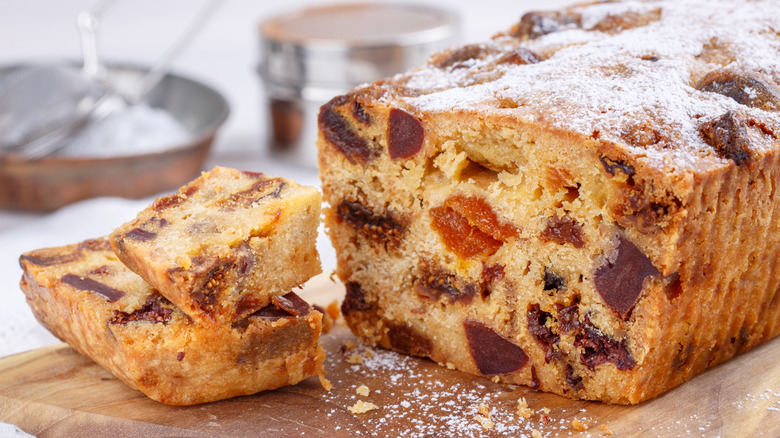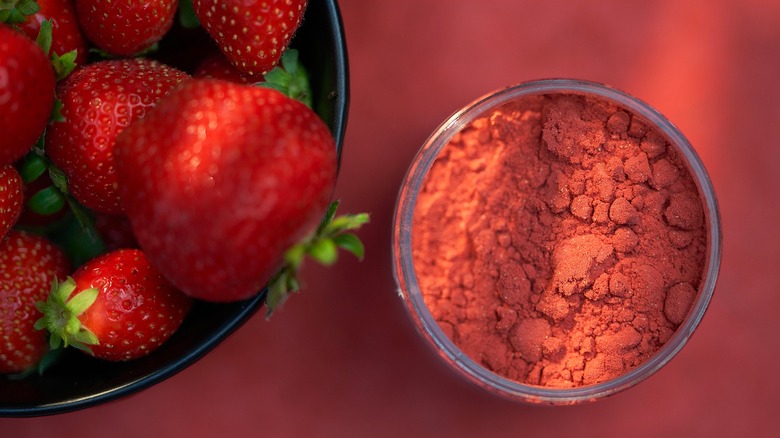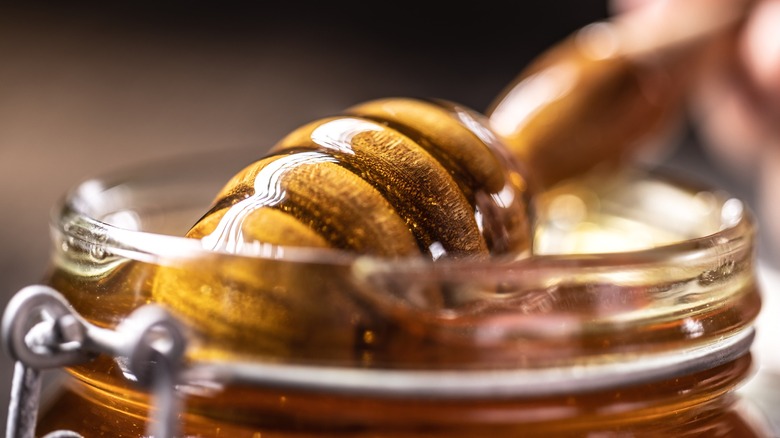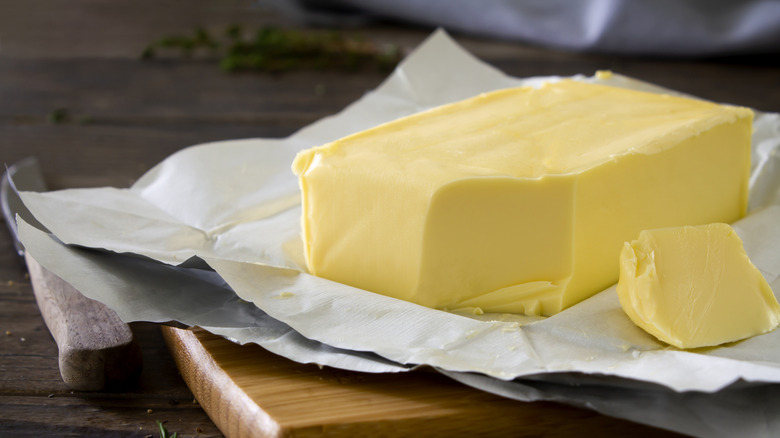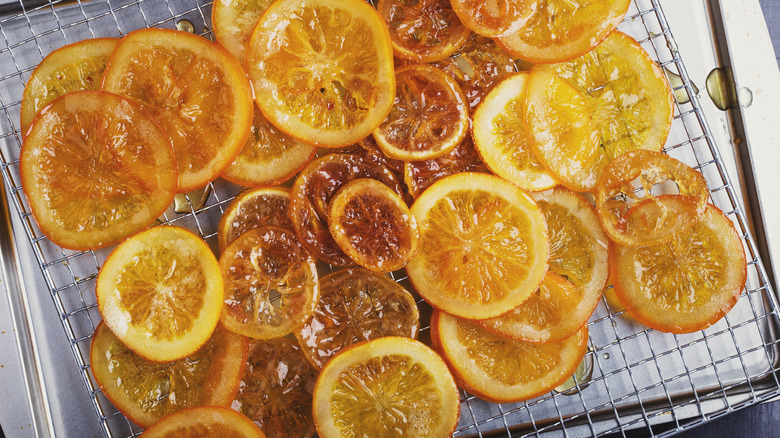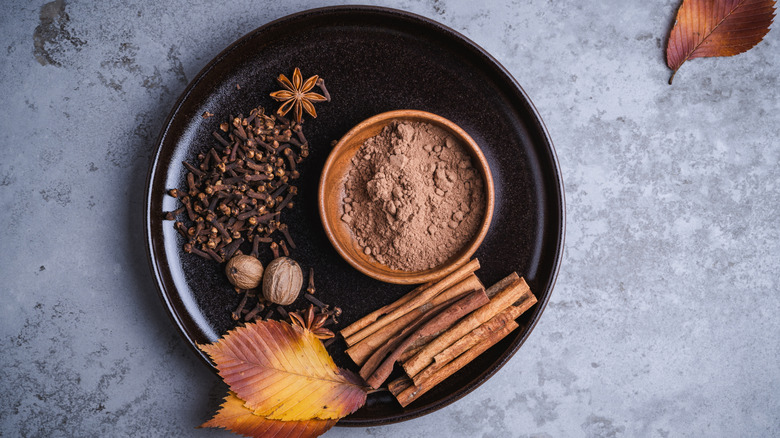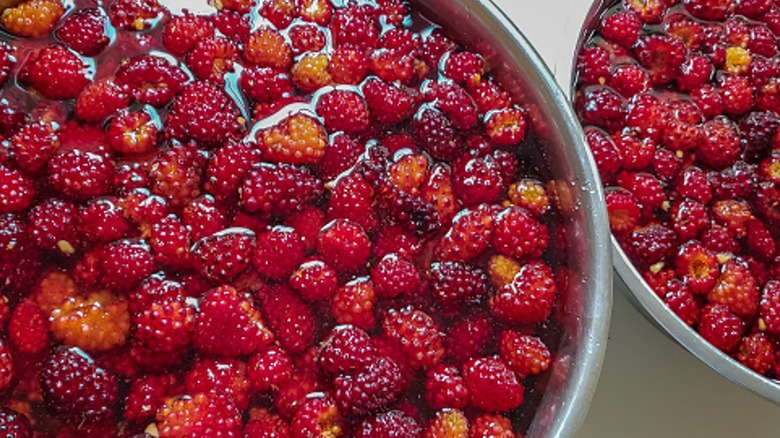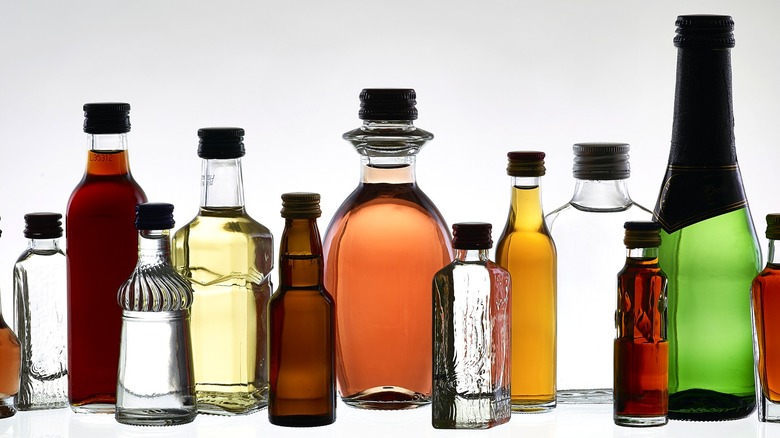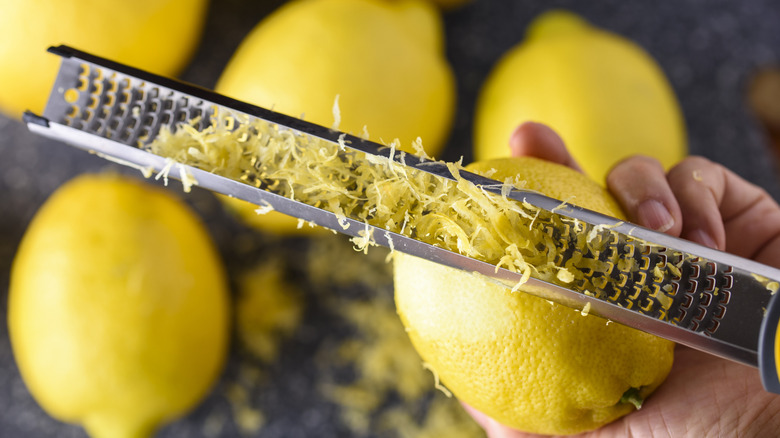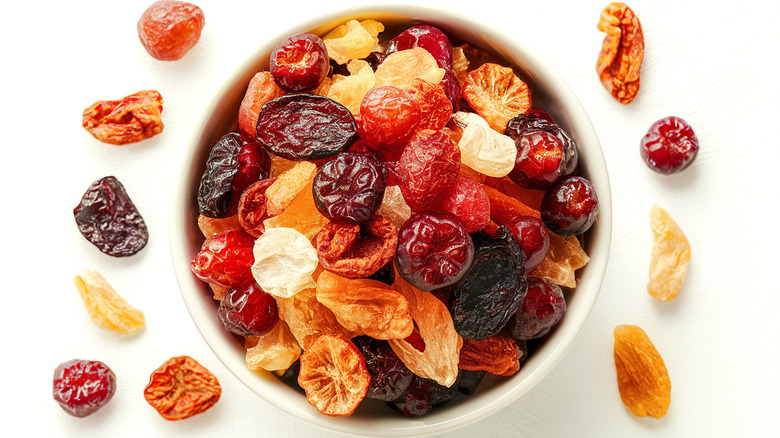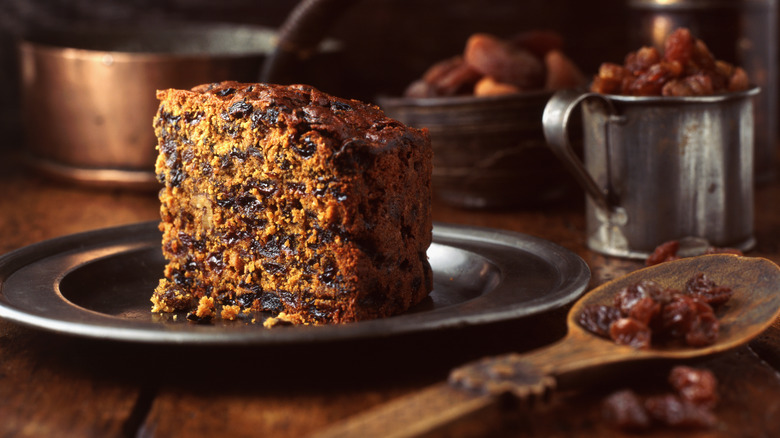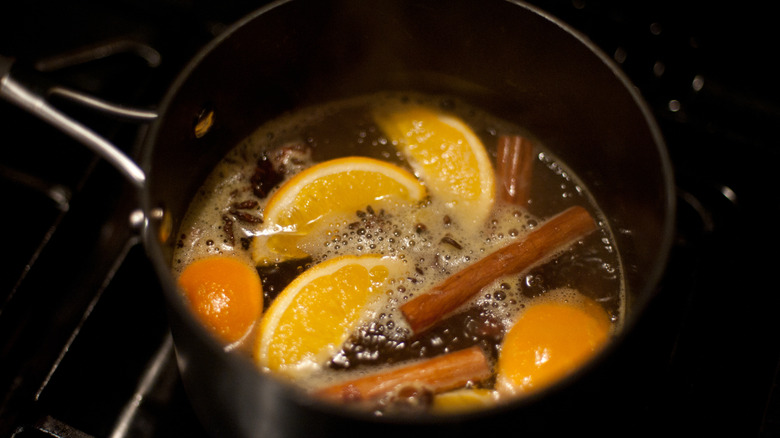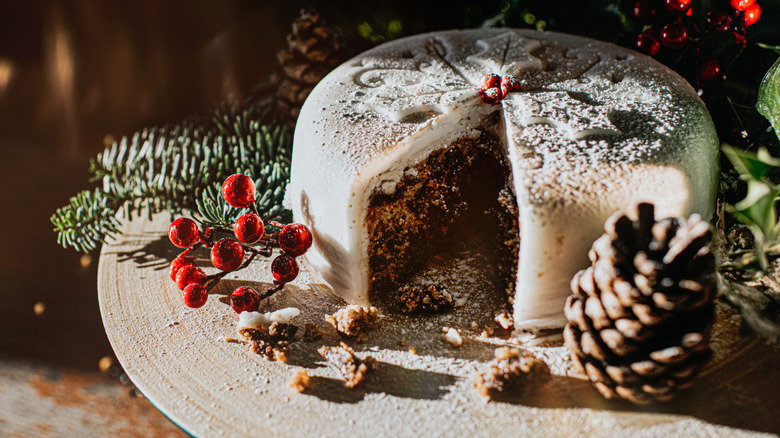12 Delicious Ways To Upgrade Your Fruitcake
We may receive a commission on purchases made from links.
The classic fruitcake gets a lot of disrespect, particularly in the United States. Many of these hard-as-rocks concoctions — which are full of preservatives and studded with bizarrely colored candied fruit — pop up around the holidays. Fruitcakes such as these are often treated as a joke; they are often referred to as what you'd give someone you're not particularly fond of, in the hopes that they might chip a tooth or drop one on their foot and break a toe. So of course, many fruitcakes could use an upgrade or two.
Fruitcakes come in all shapes and sizes, from Italy's crown-like panettone to India's generously spiced Allahabadi cake, to the dense, boozy Christmas cake that graces holiday tables in Britain. Each of these fruitcakes has its own unique personality. But what ties them together are the basic ingredients: cake batter studded with nuts, spices, and fruit, typically both candied and dried. These components can be improved with a few tricks that we'll share with you.
If you're a defender and fan of this infamous dessert, we've compiled a dozen ways for you to ensure your fruitcakes always reach the apex of deliciousness. If you're a skeptic, take these tips and give fruitcake another chance; you may find yourself with a new holiday tradition to share.
1. Use freeze-dried fruit powder to boost its flavor
One issue with fruitcake that can crop up is that it's not, well, fruity enough. Dried fruit can sometimes have a muted flavor, and candied fruit is very sweet, so adding too much can make the cake unpleasantly saccharine. Fresh fruit is flavorful, but tough to bake with. Depending on what fruit you use, a lot of moisture can be released during cooking, which can easily ruin a bake. There are fruit flavoring extracts out there, but they tend to taste artificial and a little goes a long, long way, which means it's easy to overdo it.
Bakers shouldn't give up — there's help on the way in the form of freeze-dried fruit powder. This ingredient is almost a miracle worker when it comes to fruit-based desserts like fruitcakes. It's made of pure concentrated fruit, so there's no need to worry about any off or artificial flavors. It can be mixed into just about anything, adding a burst of fruit flavor and color, without screwing up your dry-to-wet ratio. Cookie dough, cake batter, icing mix, fondant, ice cream — you name it and freeze-dried fruit powder can improve it. If you can't find powder, you can also get your hands on larger pieces of freeze-dried fruit and pulverize them yourself using a spice or coffee grinder — like these freeze-dried fruits from Tala – then add the powder to your fruitcake recipe.
2. Add honey as a sweetener
Many fruitcake recipes call for granulated sugar as the sweetening agent. Others call for brown sugar, molasses, or corn syrup. Depending on the color, sweetness level, and flavor profile you're going for, any combination of these can be successful, and your cake will taste fine. However, there's one even more flavorful option that's often overlooked: honey.
Honey and fruit are a match made in heaven, so it makes sense that using a honey-sweetened cake batter for fruitcake is a good idea. Honey adds a deep, delicious, unique type of sweetness to baked goods, and adds more flavor than plain sugar. Since it's a liquid, if you're replacing sugar in a recipe, make sure you adjust everything carefully. You'll want to reduce other liquid ingredients, add baking soda to balance out its acidity, and lower the temperature of your bake so that the honey doesn't burn. Ideally, try to find a recipe that already includes honey, so that these adjustments have been made for you. Experimenting with different types of honey will give your fruitcakes subtly different flavors.
3. Use the best butter
When baking, you want to use the best ingredients you can possibly get your hands on. That's perhaps the most important thing to keep in mind with butter. Moistness, richness, rise, and flavor are all components of a cake that are driven by butter. You can improve all of these at once — and raise the quality of your entire fruitcake — by choosing the best butter for your fruitcake recipe.
That doesn't necessarily mean shelling out the big bucks for the most expensive boutique butter you can find. It does mean having a decent understanding of what different types of butter are, and how they will affect your fruitcake. The first thing to look at is butterfat: European butters are typically higher in butterfat than American butters (but not always). There are plenty of American producers making high fat products these days, too.
The range of butterfat typically runs between 80% and 85% — check the label and look for something in the middle. If your butterfat content is too low, your cake will be lacking in flavor. If it's too high, your cake can turn out heavy and flat. And, for more flavor and a bright tang, you can also use cultured butter instead of sweet cream butter.
4. Candy your own fruit
Using store-bought candied fruit in your fruitcake is a big shortcut, and, if you're a busy human, giving up shortcuts to take the long road is tough. However, if you want the ultimate control over your cake's flavor, quality, and sweetness level, making your own candied fruit is worth the extra time and effort. Most store-bought candied fruit contains high fructose corn syrup, along with loads of preservatives and artificial colors and flavors, so if you're looking to avoid such things, it pays to do it yourself.
The art of candying fruit is relatively simple. First, the fruit is boiled to soften it and remove any impurities. Then, it's cooked in simple syrup (a mixture of sugar and water). Traditional methods require days, if not weeks, of slowly steeping whole fruits in sweeter and sweeter syrup until they're fully preserved. But by slicing the fruit into smaller pieces, and then keeping those pieces at a low simmer on the stove, you can create candied fruit much more quickly.
Once dried, candied fruits can last months, so you can start your fruitcake prep in the summer or fall to save yourself precious time once the holidays roll around. This method will also capture the fruits of each season while they're at their peak.
5. Grind some whole spices
Spice is a key component in a successful fruitcake. The melange of warm baking spices evokes that comforting holiday feel and perfectly complements the fruit and nuts that make up the bulk of the dessert. Unless you're an avid year-round baker, you might have a problem in this department — spices, particularly ground spices, don't last forever. If you haven't replaced your fall and winter spices in a long time, you're not getting the full, robust flavors and aromas that you want in your fruitcake.
Spices aren't cheap, and replacing ground spices every year can really add up. That's why, especially for seasonal spices, buying whole (instead of ground) spices is a more economical option. They last at least twice as long as ground spices, and since you grind them as you use them, you'll get a stronger, more intense flavor out of them. Cinnamon, nutmeg, anise, cloves, and allspice are all commonly used in fruitcakes. These can be easily found whole, then ground by hand using a coffee or spice grinder, a microplane, or a mortar and pestle.
6. Soak dried fruits in a flavorful liquid
Most fruitcake recipes start with the same step: Reconstituting dried fruits in liquid, often letting them macerate overnight. This process plumps up the fruits with moisture and also adds flavor from whatever liquid you use. While spirits like brandy or rum are commonly called for, you can really use whatever liquid you like. Trying to keep your cake alcohol-free? Try fruit juice, non-alcoholic cider, or even a strongly brewed tea of your choice.
If you're in a pinch and don't have anything else around, you can theoretically use water to hydrate your fruit, but you'll be missing out on an extra layer of flavor development. Experiment with your favorite flavors and see how they affect the fruit. Anything goes — wine, beer, and liqueurs will all add their own twist. Whatever flavor profile you're going for with your fruit, try to find what liquid complements it best.
7. Experiment with unique types of alcohol
Alcohol is often a major component in fruitcake recipes. While it's not strictly necessary, and can be replaced by non-alcoholic liquids, if you're going for a traditional recipe, you'll want to booze your fruitcake up. As explained above, the first step in a recipe typically involves soaking dried fruits in a spirit (usually brandy or rum). Alcohol is also applied to the cake after it's baked as a way to preserve its shelf life and moisture content. The aforementioned brandy and rum will give your fruitcake a classic flavor profile, but if you're looking to mix things up, there are a lot of other spirits and liqueurs to consider.
If you want to punch up the spice flavors in your cake, try rye whiskey instead. A fruitcake that boasts lots of tropical fruits like mango and pineapple would be well complemented by a tequila (either a blanco for a brighter flavor or a reposado or añejo for something richer and deeper). Applejack brandy or calvados, which are distilled from apples and pears, would greatly amplify the fruit flavors in your cake. Pisco, a South American brandy made from aromatic grapes, will add a perfumed floral note. There are endless liqueurs, fruit and otherwise, that can be used as well, but be aware of the level of sweetness in each.
8. Use freshly grated citrus zest instead of extracts
Depending on the style of fruitcake you're making, you can run the risk of having a finished product that's incredibly dense, heavy, and rich, and desperately in need of a brighter element to help balance it out. Candied citrus peels are called for in most fruitcake recipes, which add not just a mild citrus flavor, but sweetness, too. If your cake is already quite sweet, these candied peels may be harming more than they're helping when it comes to balance. In that case, you'll want to grab your zester.
Adding freshly grated citrus zest to your cake is a simple way to lighten and brighten its flavors. The sharpness will mellow out somewhat during the baking process, but fresh zest will still add more intensity than the candied versions of the same. Stick with classic lemon and orange, or experiment with other types of citrus. Just be sure you're not grating the white pith along with the outer rind, as it can add an unpleasant bitter flavor.
9. Experiment with nontraditional fruits
You can let your individual tastes shine, and you make your fruitcake your own, through your choice of fruits. Golden raisins, cherries, pineapple, and apricots are often found in traditional recipes, but there are no rules. Dried fruit has no season, so you can choose whatever combination you fancy. Any combination of candied and dried fruits, along with freeze-dried fruit powder if you're using it, is doable — it really just depends on your personal taste.
You can focus on a single season of fruit, as they tend to complement each other well. Celebrate fall with persimmons, apples, and pears, which match up fabulously with traditional fruitcake spices. Bring a touch of summer to your fruitcake with a combination of peaches, nectarines, and plums. A tropical fruitcake consisting of mangoes, papayas, passionfruit, and kiwis can bring a bright and breezy vibe to your holiday feast. Citrus and nuts go well with any of these flavor profiles, so don't be afraid to think outside of the box. Drying fruit yourself is easy and doesn't require any fancy equipment — just an oven and a few hours.
10. Age the cake for a deeper flavor
There's no law against enjoying a fruitcake right out of the oven, but to experience its true flavor, you'll want to let it age, much like a fine wine. Soaking the cake in alcohol keeps it preserved while it ages, anywhere from a few weeks to a few months to a year or more. It may seem bizarre to have a baked dessert with such a lengthy shelf life, but sugar and alcohol work well together as natural preservatives, keeping away the microscopic critters that cause rot and dangerous foodborne illnesses.
While you can theoretically still safely eat a fruitcake that's been aging for decades or even a century, that kind of longevity is by no means necessary — or even desirable — when it comes to aging the cake. A couple of weeks or months, which is a much more practical period of time, is enough to add significant layers of depth and dimension to the cake. The keys are keeping it in a cool, dark place, and ensuring it stays moist and bacteria-free by periodically brushing or spritzing it with the alcohol of your choice. Another preservation method involves soaking cheesecloth in your preferred spirit and wrapping it around the cake, thus keeping it covered and boozy. When the cheesecloth starts to dry out, soak it again and re-wrap it.
11. Bathe your dry cake before serving it
This tip applies mainly to store-bought cakes, but it can also help you if your homemade cake turns out to be less than stellar. If you find yourself with a dry, dense, inedibly tough fruitcake, you don't need to throw it away or send it to your worst enemy. As long as the cake isn't beyond help — rancid, moldy, or otherwise lethally flawed — it can be resuscitated with a little care and effort, and turned into something not just edible, but delicious.
The secret is moisture. The trick is to get moisture inside the cake, and this can be achieved in a few ways. Start by poking holes in the cake (not all the way through, and not so many that it falls apart). Then, you can employ any of the methods you'd use to keep the fruitcake moist during the aging process, by dousing, brushing, or wrapping the cake in spirit-soaked cheesecloth. This will take time, though, as you have to let the liquid make its way through the dry interior. The faster way is to heat up a pan of your spirit, wine, or juice — along with any other desired flavorings like fruit or spices — and ladle the hot liquid over the cake. The combination of heat and liquid will allow the cake to soften and moisten, while also adding more flavor. Be cautious when heating spirits, as they can be flammable.
12. Top it with a sauce, glaze, or icing
The fruitcake's reputation as a loathed dessert is possibly at least partially due to its typical appearance. Although fruitcakes can be quite beautiful, just as often they're served looking like rugged bricks of mud studded with irregularly shaped and sized nuggets that are often unrecognizable as food. It's no wonder so many people turn their noses up at such an unappealing concoction, without even having a bite. Fruitcakes, though, can be made in any shape, and there's no reason not to treat them just like any other cake when it comes to dressing up the appearance of fruitcakes.
Marzipan, a decorative paste made from almonds, is commonly used as a fruitcake topping in England, and its nutty sweetness perfectly enhances the cake underneath. Fondant makes a smooth, professional statement and can be further decorated, adding elegance to the normally rustic fruitcake. Some fruitcakes call for cocoa powder in the cake batter and can be made even more chocolatey with an outer layer of ganache. Traditional cake frostings like buttercream or cream cheese can be very sweet and decadent, but why not go all out for the holidays? For more subtle toppings, drizzle the cake with a honey or sugar glaze, or even a layer of jam to really punch up the fruit flavors, and some fresh citrus zest on top.
